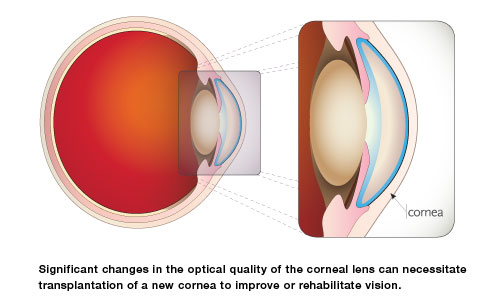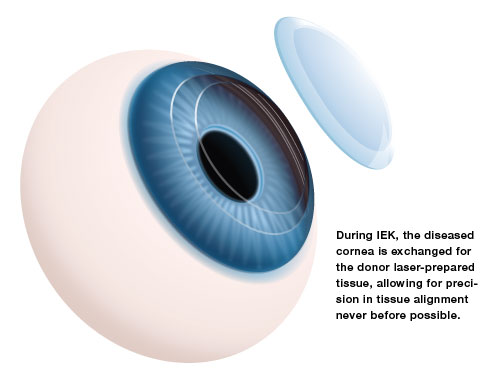Significant changes in the optical quality of the cornea can necessitate transplantation of a new cornea to improve or rehabilitate vision.
-
Corneal Transplantation
With the advent of ever-improving technology in microsurgery, eye banking and laser applications, modern corneal transplant surgery has evolved into a technique associated with reliable safety and impressive visual rehabilitation for a wide variety of corneal conditions once thought incurable.
The cornea is the clear, front surface of the eye that is responsible for focusing light onto the retina. The eye has a two-lens system to produce this focused image and the cornea functions as its primary lens. As such, any condition inherited or acquired that has an impact on corneal clarity or shape will have an impact on the ability to see well.

DIAGNOSING CORNEAL DISEASES
A comprehensive eye exam is the first step in determining if you are a good candidate for corneal transplant surgery. Your surgeon will personally assess your individual situation and determine if a corneal transplant will help restore your vision.
What are some common reasons for corneal transplantation?
-
Keratoconus
This is a progressive condition that causes the cornea to thin and develop an irregular shape. This condition can often be initially treated with hard contact lens wear, but many patients will eventually require surgery.
-
Infections
Following infections, scar tissue can develop causing the cornea to lose its transparency. Corneal transplantation is an option to remove corneal scarring.
-
Corneal Swelling (EDEMA)
Corneal swelling due to inherited disorders or poorly tolerated eye surgery can result in loss of corneal transparency. Corneal transplantation is the only treatment for irreversible corneal swelling..
-
What is corneal transplant?
In the simplest of terms, a corneal transplant is a microsurgical procedure in which all or a portion of a damaged cornea is replaced with a donor cornea tissue. Corneal transplantation (keratoplasty) has become one of the most sophisticated and successful transplant operations performed today. With the advent of ever-improving microsurgical techniques, modern corneal transplant surgery has become safe, reliable and associated with impressive visual rehabilitation for corneal conditions once thought incurable.
-
Where are the donor corneas obtained?
The new cornea is supplied by an eye bank, an institution that harvests donor tissue from around the country. Eye donors are individuals who have chosen to give the gift of sight to others after their passing. It is the function of the eye bank to carefully screen, examine and process these donor corneas to determine if the tissue is suitable and safe for transplantation. Once this process is complete, a communication occurs between the eye bank and the corneal surgeon who has requested tissue for their patient. The corneal surgeon must then use his or her expertise in deciding whether the tissue is appropriate by considering multiple factors. Approved corneal tissue will then be forwarded for transplantation
A CORNEAL TRANSPLANT CAN RESTORE LOST VISION, REDUCE YOUR PAIN AND IMPROVE YOUR EYE’S OVERALL APPEARANCE.
WE OFFER OUR CORNEAL PATIENTS THE LATEST IN NEW AND PROVEN PROCEDURES, AMONG THEM ARE:
-
Traditional Keratoplasty
In traditional keratoplasty surgery, the entire diseased cornea is removed using a bladed system and replaced with a similarly sized and shaped donor cornea.
-
DSEK (Endothelial Keratoplasty)
In DSEK surgery, transplantation of donor tissue is limited to the very back portion of the cornea, or endothelial layer. This type of surgery may be indicated when loss of corneal clarity can be determined to be caused by a malfunction of this essential layer of the cornea. Rather than transplanting a full-thickness corneal tissue, this approach is limited to the replacement of only the most interior portion of the cornea. In DSEK surgery, the eye bank will prepare this partial-thickness donor tissue for our surgeon to position into the interior of the cornea through a microscopically small incision. A small air bubble is placed into the eye after the DSEK button is positioned to assist in its adherence. DSEK surgery can provide safe and faster visual recovery for the patient with endothelial disease.
-
Intralase-Assisted Keratoplasty (IEK)
This is a technology that can allow for an impressive improvement in surgical precision and a rapidity of improved visual function never before attainable with traditional corneal transplant surgery. Using the same IntraLase laser used in LASIK surgery, a precise pattern of microscopically placed laser pulses are placed into the patient’s diseased cornea as calculated and specified by our surgeon. The very same shaped pattern is then communicated to the eye bank in the preparation of the donor cornea accepted for transplantation. At the time of surgery, the diseased cornea is exchanged for the donor laser-prepared tissue, allowing for precision in tissue alignment never before possible. IEK patients enjoy a speedier recovery of vision, with less astigmatism and more comfort. The IEK option is associated with additional charges to the patient, as it is not a covered service with most insurance companies.

WILL I NEED TO SPEND THE NIGHT IN THE HOSPITAL?
No. Most keratoplasty procedures are not lengthy, with most cases averaging less than one hour in the operating room. This can vary of course, depending on the nature of your individual problem. Surgery is performed under local or general anesthesia, again depending on individual circumstances. In all cases, anesthesia is supervised by a staff of qualified anesthesiologists who will assure that you are comfortable and relaxed at all times.
Once your surgery is completed you will be transferred to a recovery area where you will remain under the care of our nursing staff until stable. Most patients recover rapidly and are able to return home within several hours after surgery.
Our staff will provide you with postoperative medication prescriptions and instructions for home care. When you leave the surgical facility your eye will be covered with a cotton eye pad and protective eye shield, which are to remain in place until your first postoperative visit on the day after surgery. Bed rest is advisable upon returning home, with your head slightly elevated. You should try to avoid sleeping on the operated side. Mild to moderate discomfort may be experienced, in which pain medication may be prescribed for use.
A SUCCESSFUL SURGERY REQUIRES THE ATTENTION AND CARE OF BOTH THE SURGEON AND THE PATIENT.
HOW LONG IS THE RECOVERY PERIOD?
Your surgeon will examine your eye the day after surgery. Instructions for continuing care will be given at that time, including advice on a schedule for your return to work and other activities. You can anticipate that your vision may be somewhat cloudy at first, but much of this will clear over several weeks of recovery. You will be asked to replace your protective eye shield when sleeping or bathing. Your surgeon will will go over your post-operative care with you.


